NUR3018: Teaching Plan on Barrier Nursing and Infection Control
VerifiedAdded on 2022/08/22
|9
|1824
|23
Project
AI Summary
This assignment is a comprehensive teaching plan focused on barrier nursing and infection control, designed for first-year nursing students. It covers the introduction, lesson plan, evaluation methods, and conclusion. The introduction emphasizes the importance of infection control in healthcare settings and discusses the need for barrier nursing to prevent the spread of infections. It also highlights the use of peer teaching and learning theories such as behaviorism, cognitive, and constructive theories. The lesson plan section provides a detailed template with objectives, session length, resources, and learner characteristics. It outlines various teaching modalities like case studies, focus groups, role-playing, group discussions, educational booklets, and personal response systems. The evaluation part describes formative, summative, and continuous assessment techniques, including direct observation, questioning, and self-assessment. The conclusion reiterates the importance of effective communication, teaching plans, and assessment methods in educating student nurses on infection control and barrier nursing. The plan is supported by multiple references to relevant literature.
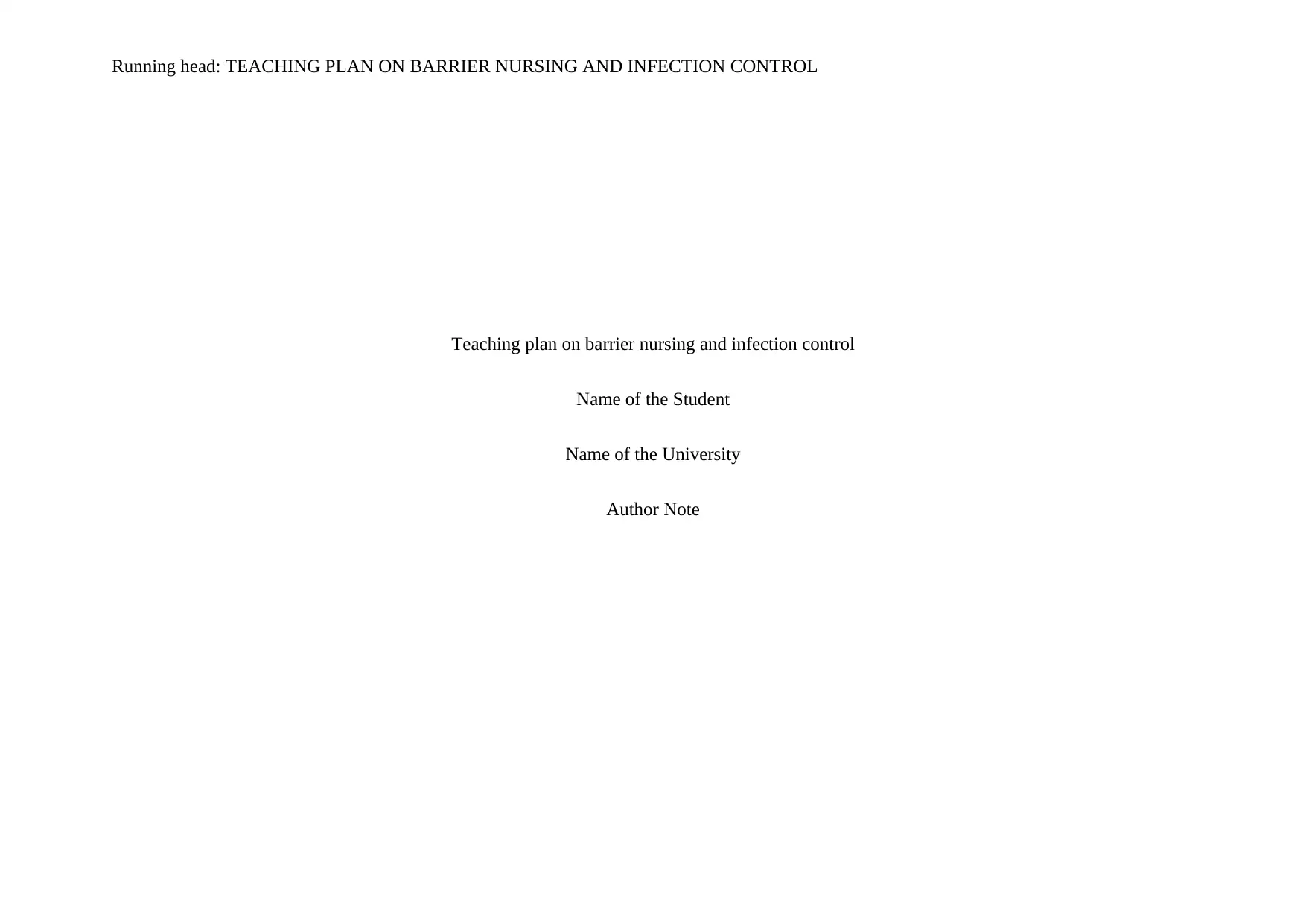
Running head: TEACHING PLAN ON BARRIER NURSING AND INFECTION CONTROL
Teaching plan on barrier nursing and infection control
Name of the Student
Name of the University
Author Note
Teaching plan on barrier nursing and infection control
Name of the Student
Name of the University
Author Note
Paraphrase This Document
Need a fresh take? Get an instant paraphrase of this document with our AI Paraphraser
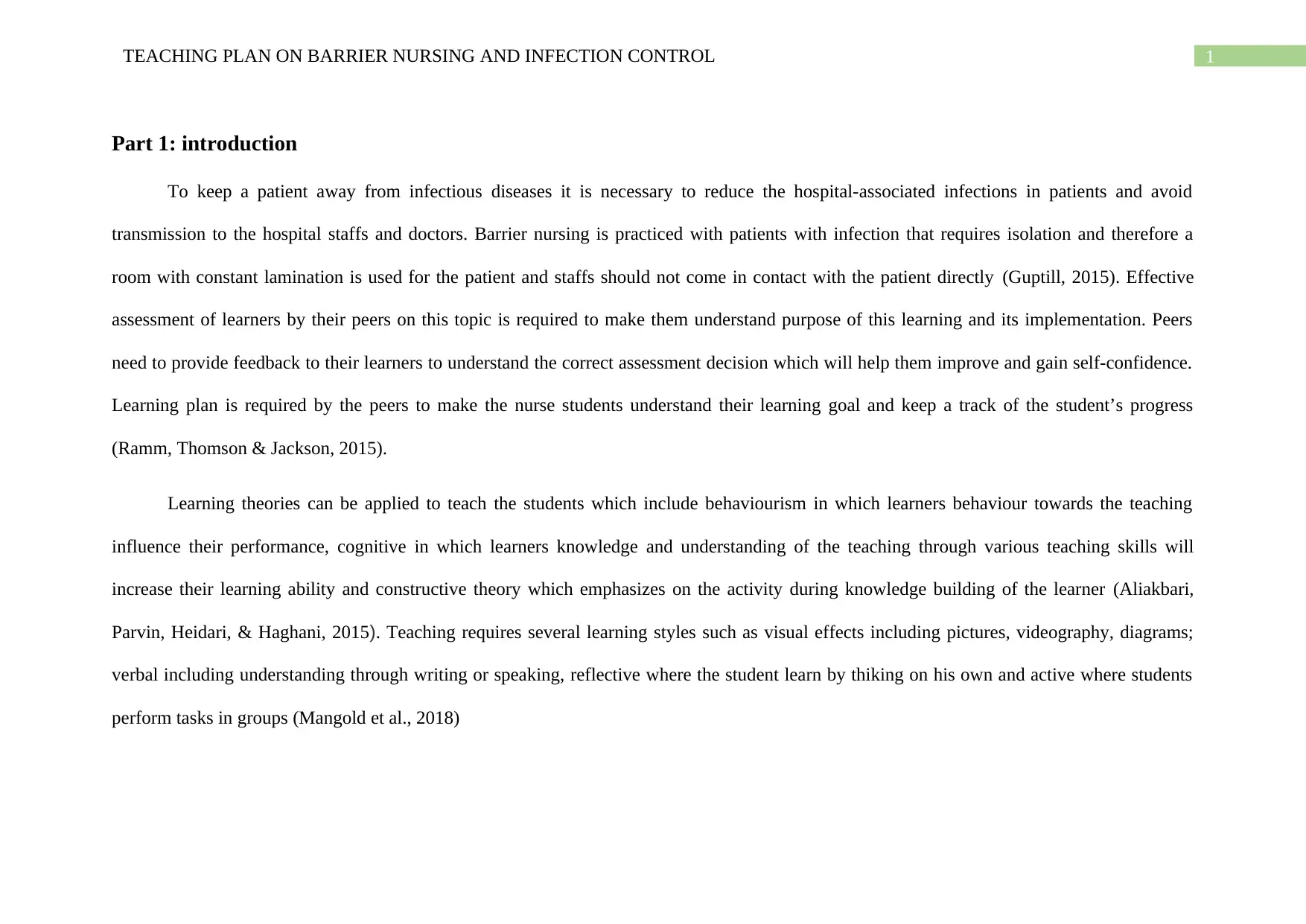
1TEACHING PLAN ON BARRIER NURSING AND INFECTION CONTROL
Part 1: introduction
To keep a patient away from infectious diseases it is necessary to reduce the hospital-associated infections in patients and avoid
transmission to the hospital staffs and doctors. Barrier nursing is practiced with patients with infection that requires isolation and therefore a
room with constant lamination is used for the patient and staffs should not come in contact with the patient directly (Guptill, 2015). Effective
assessment of learners by their peers on this topic is required to make them understand purpose of this learning and its implementation. Peers
need to provide feedback to their learners to understand the correct assessment decision which will help them improve and gain self-confidence.
Learning plan is required by the peers to make the nurse students understand their learning goal and keep a track of the student’s progress
(Ramm, Thomson & Jackson, 2015).
Learning theories can be applied to teach the students which include behaviourism in which learners behaviour towards the teaching
influence their performance, cognitive in which learners knowledge and understanding of the teaching through various teaching skills will
increase their learning ability and constructive theory which emphasizes on the activity during knowledge building of the learner (Aliakbari,
Parvin, Heidari, & Haghani, 2015). Teaching requires several learning styles such as visual effects including pictures, videography, diagrams;
verbal including understanding through writing or speaking, reflective where the student learn by thiking on his own and active where students
perform tasks in groups (Mangold et al., 2018)
Part 1: introduction
To keep a patient away from infectious diseases it is necessary to reduce the hospital-associated infections in patients and avoid
transmission to the hospital staffs and doctors. Barrier nursing is practiced with patients with infection that requires isolation and therefore a
room with constant lamination is used for the patient and staffs should not come in contact with the patient directly (Guptill, 2015). Effective
assessment of learners by their peers on this topic is required to make them understand purpose of this learning and its implementation. Peers
need to provide feedback to their learners to understand the correct assessment decision which will help them improve and gain self-confidence.
Learning plan is required by the peers to make the nurse students understand their learning goal and keep a track of the student’s progress
(Ramm, Thomson & Jackson, 2015).
Learning theories can be applied to teach the students which include behaviourism in which learners behaviour towards the teaching
influence their performance, cognitive in which learners knowledge and understanding of the teaching through various teaching skills will
increase their learning ability and constructive theory which emphasizes on the activity during knowledge building of the learner (Aliakbari,
Parvin, Heidari, & Haghani, 2015). Teaching requires several learning styles such as visual effects including pictures, videography, diagrams;
verbal including understanding through writing or speaking, reflective where the student learn by thiking on his own and active where students
perform tasks in groups (Mangold et al., 2018)
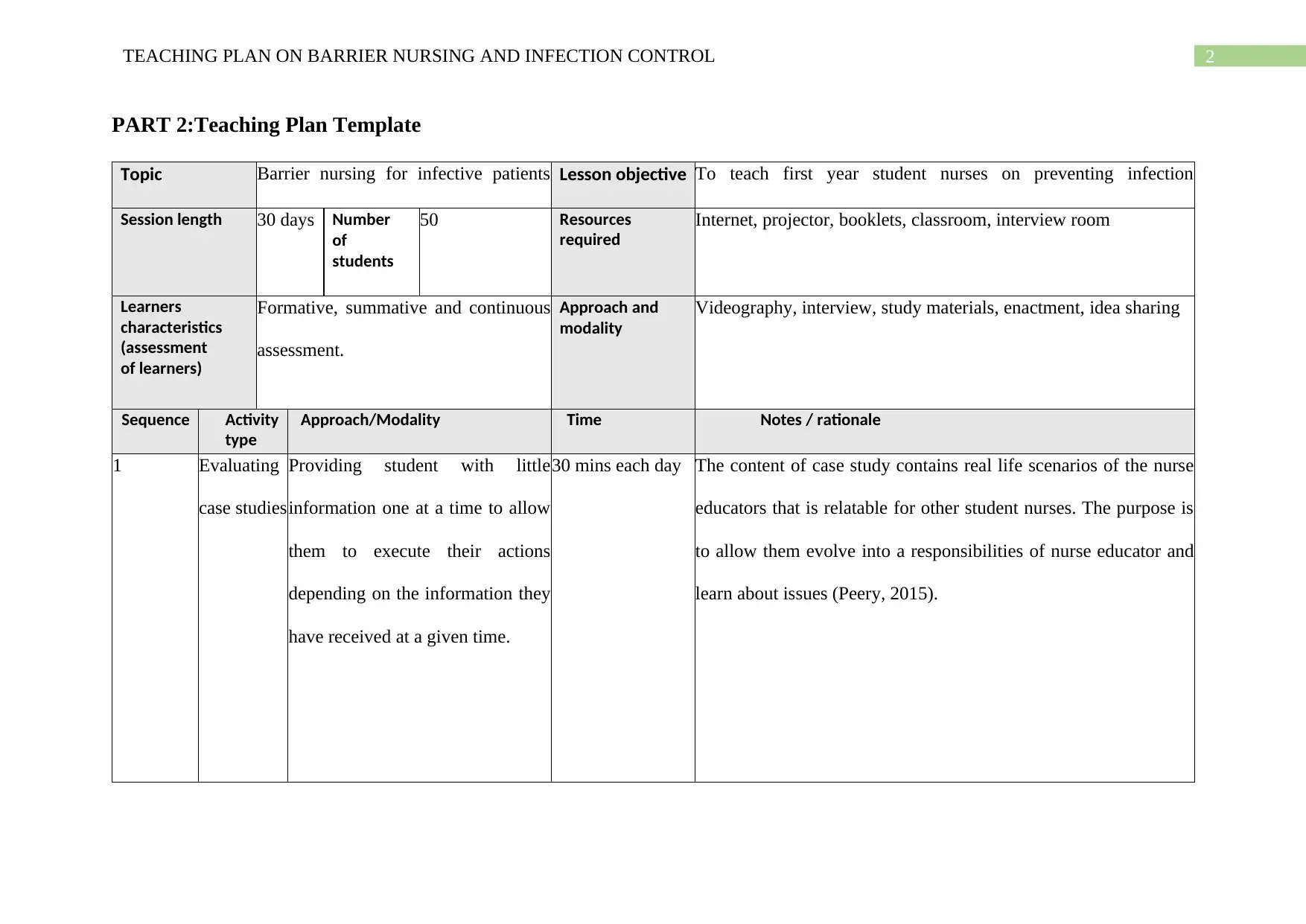
2TEACHING PLAN ON BARRIER NURSING AND INFECTION CONTROL
PART 2:Teaching Plan Template
Topic Barrier nursing for infective patients
needing isolation
Lesson objective To teach first year student nurses on preventing infection
spreadingSession length 30 days Number
of
students
50 Resources
required
Internet, projector, booklets, classroom, interview room
Learners
characteristics
(assessment
of learners)
Formative, summative and continuous
assessment.
Approach and
modality
Videography, interview, study materials, enactment, idea sharing
Sequence Activity
type
Approach/Modality Time Notes / rationale
1 Evaluating
case studies
Providing student with little
information one at a time to allow
them to execute their actions
depending on the information they
have received at a given time.
30 mins each day The content of case study contains real life scenarios of the nurse
educators that is relatable for other student nurses. The purpose is
to allow them evolve into a responsibilities of nurse educator and
learn about issues (Peery, 2015).
PART 2:Teaching Plan Template
Topic Barrier nursing for infective patients
needing isolation
Lesson objective To teach first year student nurses on preventing infection
spreadingSession length 30 days Number
of
students
50 Resources
required
Internet, projector, booklets, classroom, interview room
Learners
characteristics
(assessment
of learners)
Formative, summative and continuous
assessment.
Approach and
modality
Videography, interview, study materials, enactment, idea sharing
Sequence Activity
type
Approach/Modality Time Notes / rationale
1 Evaluating
case studies
Providing student with little
information one at a time to allow
them to execute their actions
depending on the information they
have received at a given time.
30 mins each day The content of case study contains real life scenarios of the nurse
educators that is relatable for other student nurses. The purpose is
to allow them evolve into a responsibilities of nurse educator and
learn about issues (Peery, 2015).
⊘ This is a preview!⊘
Do you want full access?
Subscribe today to unlock all pages.

Trusted by 1+ million students worldwide
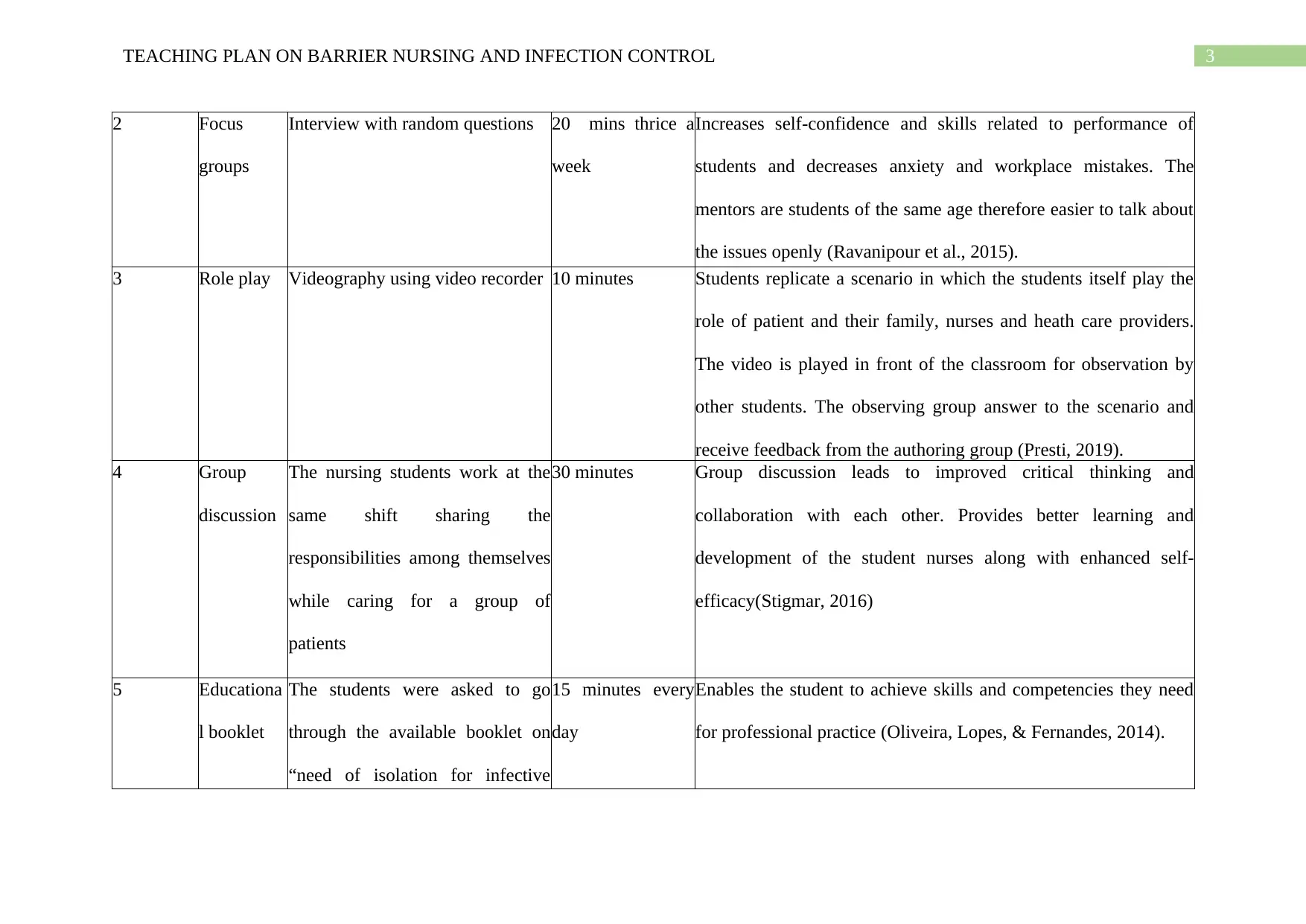
3TEACHING PLAN ON BARRIER NURSING AND INFECTION CONTROL
2 Focus
groups
Interview with random questions 20 mins thrice a
week
Increases self-confidence and skills related to performance of
students and decreases anxiety and workplace mistakes. The
mentors are students of the same age therefore easier to talk about
the issues openly (Ravanipour et al., 2015).
3 Role play Videography using video recorder 10 minutes Students replicate a scenario in which the students itself play the
role of patient and their family, nurses and heath care providers.
The video is played in front of the classroom for observation by
other students. The observing group answer to the scenario and
receive feedback from the authoring group (Presti, 2019).
4 Group
discussion
The nursing students work at the
same shift sharing the
responsibilities among themselves
while caring for a group of
patients
30 minutes Group discussion leads to improved critical thinking and
collaboration with each other. Provides better learning and
development of the student nurses along with enhanced self-
efficacy(Stigmar, 2016)
5 Educationa
l booklet
The students were asked to go
through the available booklet on
“need of isolation for infective
patients”
15 minutes every
day
Enables the student to achieve skills and competencies they need
for professional practice (Oliveira, Lopes, & Fernandes, 2014).
2 Focus
groups
Interview with random questions 20 mins thrice a
week
Increases self-confidence and skills related to performance of
students and decreases anxiety and workplace mistakes. The
mentors are students of the same age therefore easier to talk about
the issues openly (Ravanipour et al., 2015).
3 Role play Videography using video recorder 10 minutes Students replicate a scenario in which the students itself play the
role of patient and their family, nurses and heath care providers.
The video is played in front of the classroom for observation by
other students. The observing group answer to the scenario and
receive feedback from the authoring group (Presti, 2019).
4 Group
discussion
The nursing students work at the
same shift sharing the
responsibilities among themselves
while caring for a group of
patients
30 minutes Group discussion leads to improved critical thinking and
collaboration with each other. Provides better learning and
development of the student nurses along with enhanced self-
efficacy(Stigmar, 2016)
5 Educationa
l booklet
The students were asked to go
through the available booklet on
“need of isolation for infective
patients”
15 minutes every
day
Enables the student to achieve skills and competencies they need
for professional practice (Oliveira, Lopes, & Fernandes, 2014).
Paraphrase This Document
Need a fresh take? Get an instant paraphrase of this document with our AI Paraphraser
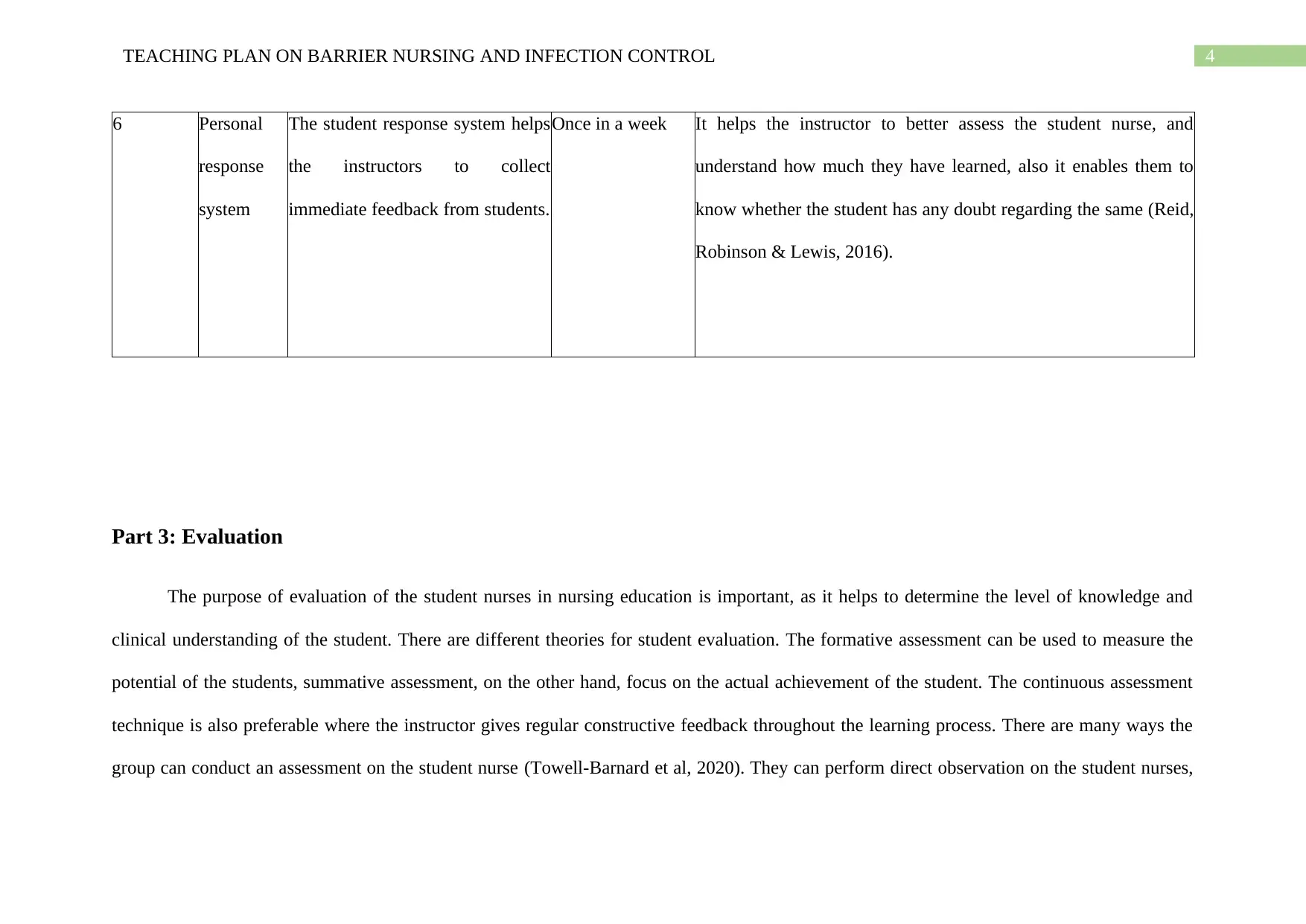
4TEACHING PLAN ON BARRIER NURSING AND INFECTION CONTROL
6 Personal
response
system
The student response system helps
the instructors to collect
immediate feedback from students.
Once in a week It helps the instructor to better assess the student nurse, and
understand how much they have learned, also it enables them to
know whether the student has any doubt regarding the same (Reid,
Robinson & Lewis, 2016).
Part 3: Evaluation
The purpose of evaluation of the student nurses in nursing education is important, as it helps to determine the level of knowledge and
clinical understanding of the student. There are different theories for student evaluation. The formative assessment can be used to measure the
potential of the students, summative assessment, on the other hand, focus on the actual achievement of the student. The continuous assessment
technique is also preferable where the instructor gives regular constructive feedback throughout the learning process. There are many ways the
group can conduct an assessment on the student nurse (Towell-Barnard et al, 2020). They can perform direct observation on the student nurses,
6 Personal
response
system
The student response system helps
the instructors to collect
immediate feedback from students.
Once in a week It helps the instructor to better assess the student nurse, and
understand how much they have learned, also it enables them to
know whether the student has any doubt regarding the same (Reid,
Robinson & Lewis, 2016).
Part 3: Evaluation
The purpose of evaluation of the student nurses in nursing education is important, as it helps to determine the level of knowledge and
clinical understanding of the student. There are different theories for student evaluation. The formative assessment can be used to measure the
potential of the students, summative assessment, on the other hand, focus on the actual achievement of the student. The continuous assessment
technique is also preferable where the instructor gives regular constructive feedback throughout the learning process. There are many ways the
group can conduct an assessment on the student nurse (Towell-Barnard et al, 2020). They can perform direct observation on the student nurses,
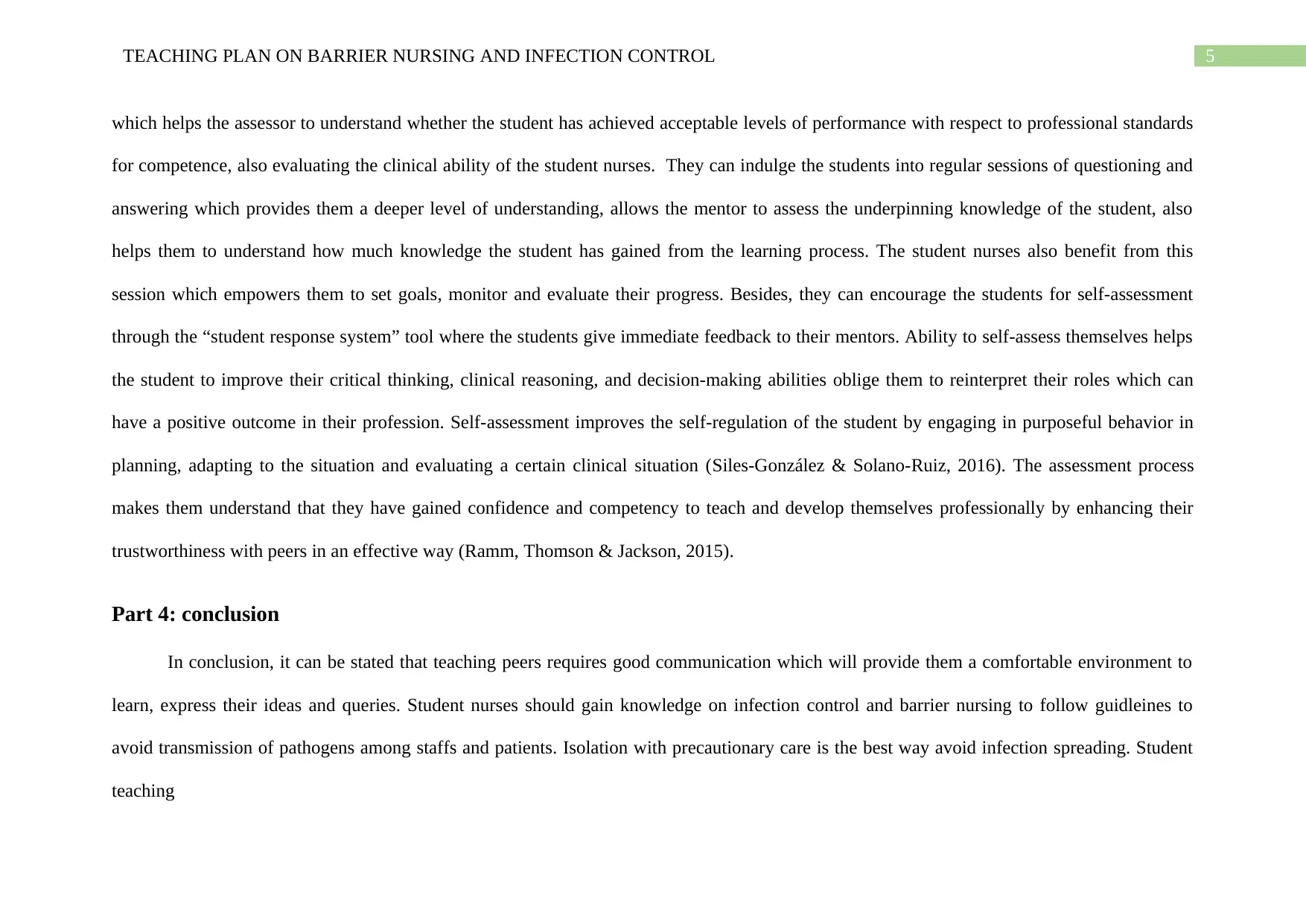
5TEACHING PLAN ON BARRIER NURSING AND INFECTION CONTROL
which helps the assessor to understand whether the student has achieved acceptable levels of performance with respect to professional standards
for competence, also evaluating the clinical ability of the student nurses. They can indulge the students into regular sessions of questioning and
answering which provides them a deeper level of understanding, allows the mentor to assess the underpinning knowledge of the student, also
helps them to understand how much knowledge the student has gained from the learning process. The student nurses also benefit from this
session which empowers them to set goals, monitor and evaluate their progress. Besides, they can encourage the students for self-assessment
through the “student response system” tool where the students give immediate feedback to their mentors. Ability to self-assess themselves helps
the student to improve their critical thinking, clinical reasoning, and decision-making abilities oblige them to reinterpret their roles which can
have a positive outcome in their profession. Self-assessment improves the self-regulation of the student by engaging in purposeful behavior in
planning, adapting to the situation and evaluating a certain clinical situation (Siles-González & Solano-Ruiz, 2016). The assessment process
makes them understand that they have gained confidence and competency to teach and develop themselves professionally by enhancing their
trustworthiness with peers in an effective way (Ramm, Thomson & Jackson, 2015).
Part 4: conclusion
In conclusion, it can be stated that teaching peers requires good communication which will provide them a comfortable environment to
learn, express their ideas and queries. Student nurses should gain knowledge on infection control and barrier nursing to follow guidleines to
avoid transmission of pathogens among staffs and patients. Isolation with precautionary care is the best way avoid infection spreading. Student
teaching
which helps the assessor to understand whether the student has achieved acceptable levels of performance with respect to professional standards
for competence, also evaluating the clinical ability of the student nurses. They can indulge the students into regular sessions of questioning and
answering which provides them a deeper level of understanding, allows the mentor to assess the underpinning knowledge of the student, also
helps them to understand how much knowledge the student has gained from the learning process. The student nurses also benefit from this
session which empowers them to set goals, monitor and evaluate their progress. Besides, they can encourage the students for self-assessment
through the “student response system” tool where the students give immediate feedback to their mentors. Ability to self-assess themselves helps
the student to improve their critical thinking, clinical reasoning, and decision-making abilities oblige them to reinterpret their roles which can
have a positive outcome in their profession. Self-assessment improves the self-regulation of the student by engaging in purposeful behavior in
planning, adapting to the situation and evaluating a certain clinical situation (Siles-González & Solano-Ruiz, 2016). The assessment process
makes them understand that they have gained confidence and competency to teach and develop themselves professionally by enhancing their
trustworthiness with peers in an effective way (Ramm, Thomson & Jackson, 2015).
Part 4: conclusion
In conclusion, it can be stated that teaching peers requires good communication which will provide them a comfortable environment to
learn, express their ideas and queries. Student nurses should gain knowledge on infection control and barrier nursing to follow guidleines to
avoid transmission of pathogens among staffs and patients. Isolation with precautionary care is the best way avoid infection spreading. Student
teaching
⊘ This is a preview!⊘
Do you want full access?
Subscribe today to unlock all pages.

Trusted by 1+ million students worldwide
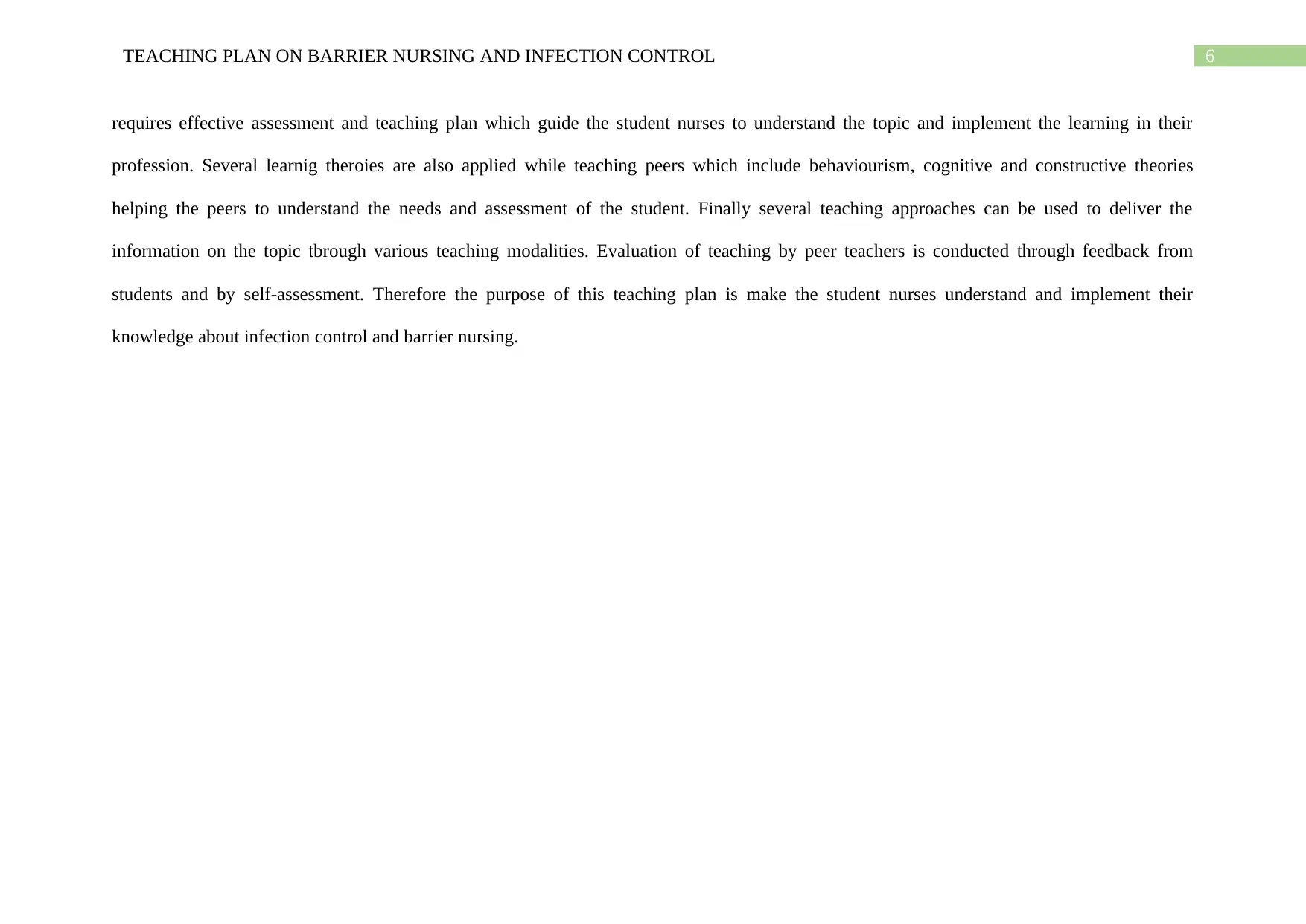
6TEACHING PLAN ON BARRIER NURSING AND INFECTION CONTROL
requires effective assessment and teaching plan which guide the student nurses to understand the topic and implement the learning in their
profession. Several learnig theroies are also applied while teaching peers which include behaviourism, cognitive and constructive theories
helping the peers to understand the needs and assessment of the student. Finally several teaching approaches can be used to deliver the
information on the topic tbrough various teaching modalities. Evaluation of teaching by peer teachers is conducted through feedback from
students and by self-assessment. Therefore the purpose of this teaching plan is make the student nurses understand and implement their
knowledge about infection control and barrier nursing.
requires effective assessment and teaching plan which guide the student nurses to understand the topic and implement the learning in their
profession. Several learnig theroies are also applied while teaching peers which include behaviourism, cognitive and constructive theories
helping the peers to understand the needs and assessment of the student. Finally several teaching approaches can be used to deliver the
information on the topic tbrough various teaching modalities. Evaluation of teaching by peer teachers is conducted through feedback from
students and by self-assessment. Therefore the purpose of this teaching plan is make the student nurses understand and implement their
knowledge about infection control and barrier nursing.
Paraphrase This Document
Need a fresh take? Get an instant paraphrase of this document with our AI Paraphraser
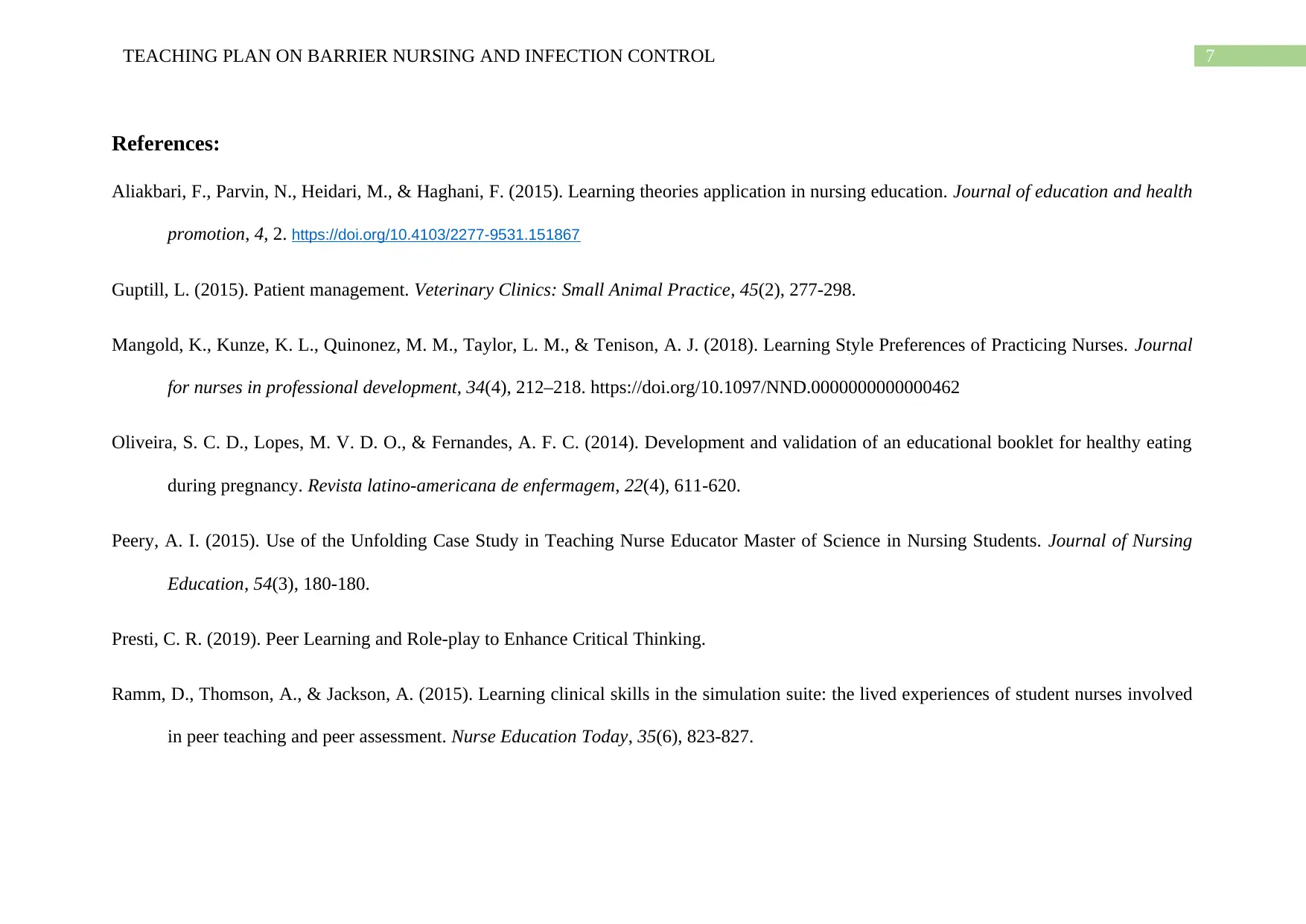
7TEACHING PLAN ON BARRIER NURSING AND INFECTION CONTROL
References:
Aliakbari, F., Parvin, N., Heidari, M., & Haghani, F. (2015). Learning theories application in nursing education. Journal of education and health
promotion, 4, 2. https://doi.org/10.4103/2277-9531.151867
Guptill, L. (2015). Patient management. Veterinary Clinics: Small Animal Practice, 45(2), 277-298.
Mangold, K., Kunze, K. L., Quinonez, M. M., Taylor, L. M., & Tenison, A. J. (2018). Learning Style Preferences of Practicing Nurses. Journal
for nurses in professional development, 34(4), 212–218. https://doi.org/10.1097/NND.0000000000000462
Oliveira, S. C. D., Lopes, M. V. D. O., & Fernandes, A. F. C. (2014). Development and validation of an educational booklet for healthy eating
during pregnancy. Revista latino-americana de enfermagem, 22(4), 611-620.
Peery, A. I. (2015). Use of the Unfolding Case Study in Teaching Nurse Educator Master of Science in Nursing Students. Journal of Nursing
Education, 54(3), 180-180.
Presti, C. R. (2019). Peer Learning and Role-play to Enhance Critical Thinking.
Ramm, D., Thomson, A., & Jackson, A. (2015). Learning clinical skills in the simulation suite: the lived experiences of student nurses involved
in peer teaching and peer assessment. Nurse Education Today, 35(6), 823-827.
References:
Aliakbari, F., Parvin, N., Heidari, M., & Haghani, F. (2015). Learning theories application in nursing education. Journal of education and health
promotion, 4, 2. https://doi.org/10.4103/2277-9531.151867
Guptill, L. (2015). Patient management. Veterinary Clinics: Small Animal Practice, 45(2), 277-298.
Mangold, K., Kunze, K. L., Quinonez, M. M., Taylor, L. M., & Tenison, A. J. (2018). Learning Style Preferences of Practicing Nurses. Journal
for nurses in professional development, 34(4), 212–218. https://doi.org/10.1097/NND.0000000000000462
Oliveira, S. C. D., Lopes, M. V. D. O., & Fernandes, A. F. C. (2014). Development and validation of an educational booklet for healthy eating
during pregnancy. Revista latino-americana de enfermagem, 22(4), 611-620.
Peery, A. I. (2015). Use of the Unfolding Case Study in Teaching Nurse Educator Master of Science in Nursing Students. Journal of Nursing
Education, 54(3), 180-180.
Presti, C. R. (2019). Peer Learning and Role-play to Enhance Critical Thinking.
Ramm, D., Thomson, A., & Jackson, A. (2015). Learning clinical skills in the simulation suite: the lived experiences of student nurses involved
in peer teaching and peer assessment. Nurse Education Today, 35(6), 823-827.
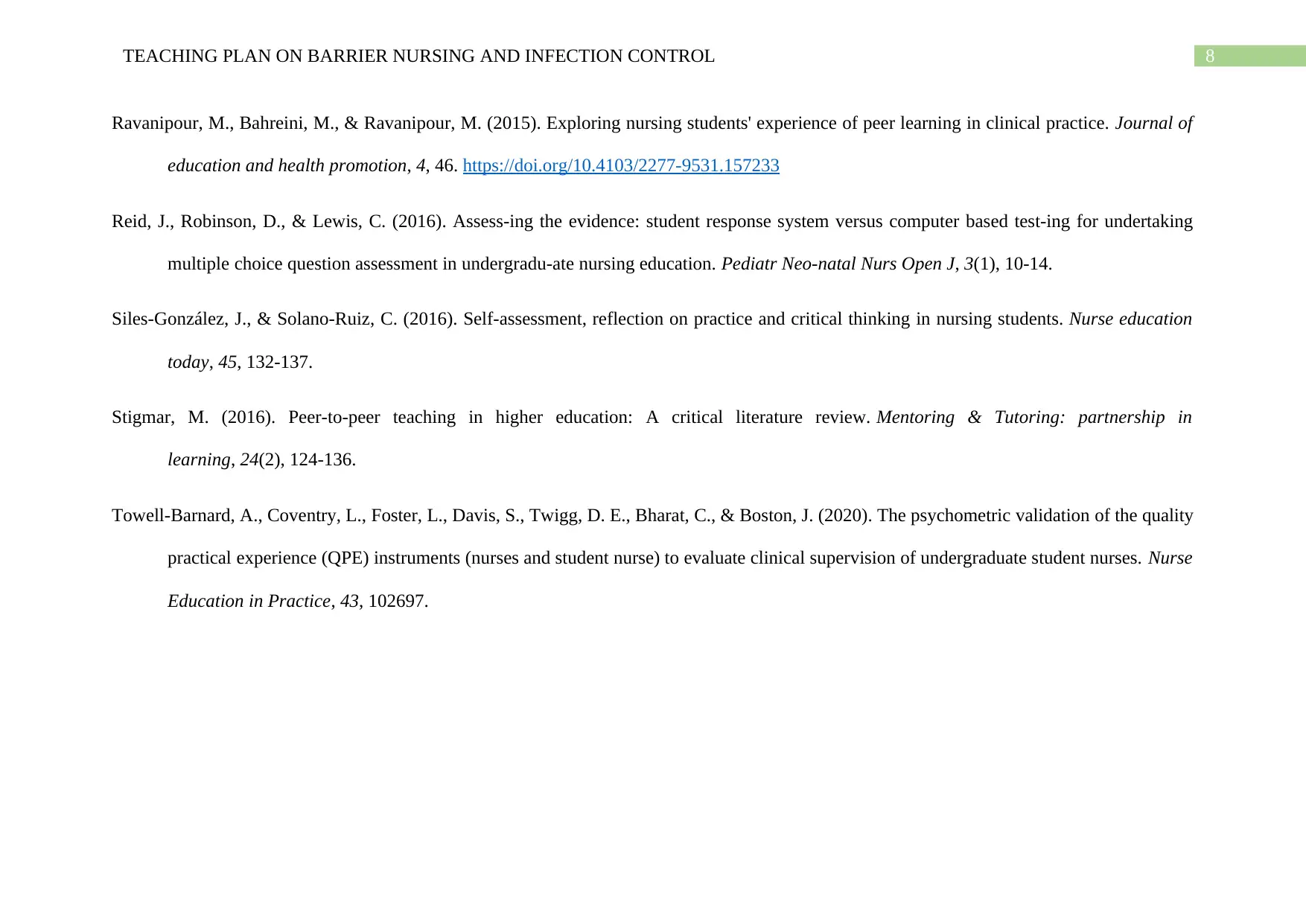
8TEACHING PLAN ON BARRIER NURSING AND INFECTION CONTROL
Ravanipour, M., Bahreini, M., & Ravanipour, M. (2015). Exploring nursing students' experience of peer learning in clinical practice. Journal of
education and health promotion, 4, 46. https://doi.org/10.4103/2277-9531.157233
Reid, J., Robinson, D., & Lewis, C. (2016). Assess-ing the evidence: student response system versus computer based test-ing for undertaking
multiple choice question assessment in undergradu-ate nursing education. Pediatr Neo-natal Nurs Open J, 3(1), 10-14.
Siles-González, J., & Solano-Ruiz, C. (2016). Self-assessment, reflection on practice and critical thinking in nursing students. Nurse education
today, 45, 132-137.
Stigmar, M. (2016). Peer-to-peer teaching in higher education: A critical literature review. Mentoring & Tutoring: partnership in
learning, 24(2), 124-136.
Towell-Barnard, A., Coventry, L., Foster, L., Davis, S., Twigg, D. E., Bharat, C., & Boston, J. (2020). The psychometric validation of the quality
practical experience (QPE) instruments (nurses and student nurse) to evaluate clinical supervision of undergraduate student nurses. Nurse
Education in Practice, 43, 102697.
Ravanipour, M., Bahreini, M., & Ravanipour, M. (2015). Exploring nursing students' experience of peer learning in clinical practice. Journal of
education and health promotion, 4, 46. https://doi.org/10.4103/2277-9531.157233
Reid, J., Robinson, D., & Lewis, C. (2016). Assess-ing the evidence: student response system versus computer based test-ing for undertaking
multiple choice question assessment in undergradu-ate nursing education. Pediatr Neo-natal Nurs Open J, 3(1), 10-14.
Siles-González, J., & Solano-Ruiz, C. (2016). Self-assessment, reflection on practice and critical thinking in nursing students. Nurse education
today, 45, 132-137.
Stigmar, M. (2016). Peer-to-peer teaching in higher education: A critical literature review. Mentoring & Tutoring: partnership in
learning, 24(2), 124-136.
Towell-Barnard, A., Coventry, L., Foster, L., Davis, S., Twigg, D. E., Bharat, C., & Boston, J. (2020). The psychometric validation of the quality
practical experience (QPE) instruments (nurses and student nurse) to evaluate clinical supervision of undergraduate student nurses. Nurse
Education in Practice, 43, 102697.
⊘ This is a preview!⊘
Do you want full access?
Subscribe today to unlock all pages.

Trusted by 1+ million students worldwide
1 out of 9
Related Documents
Your All-in-One AI-Powered Toolkit for Academic Success.
+13062052269
info@desklib.com
Available 24*7 on WhatsApp / Email
![[object Object]](/_next/static/media/star-bottom.7253800d.svg)
Unlock your academic potential
Copyright © 2020–2025 A2Z Services. All Rights Reserved. Developed and managed by ZUCOL.





